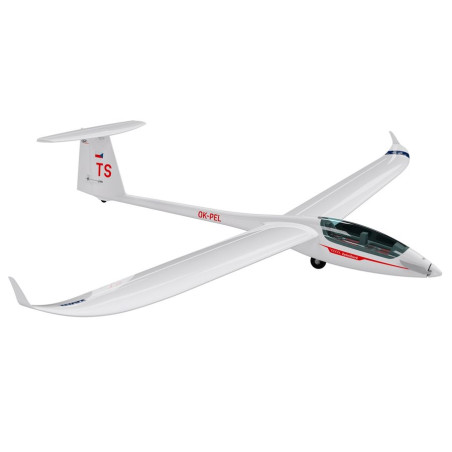











In 1962, Eugen Hänle founded Glasflügel Segelflugzeugbau GmbH. which soon became famous as the first large-scale manufacturer of laminate gliders. Their products were always characterized by innovative solutions - from the easy disassembly of the wing surface and the horizontal stabilizer, to control systems with flaps and brakes, to practical cockpit solutions that are still widely used in gliders today. After the tragic death of Eugen Hänle in a plane crash in 1975, the company ran into trouble and eventually went bankrupt in 1982.
In the mid-1990s, the young Czech company HPH (which had already made a name for itself as a producer of museum-quality model airplanes) took on the production of one of the last gliders made at Glasflügel - the 304 model. That's how gliders began to fly around the world from Kutná Hora in central Bohemia: first the HPH 304CZ produced using the original molds and instruments, then the upgraded HPH 304C Wasp 15m FAI class; then in 2006 the completely newly constructed single-seat HPH 304S Shark class 18m, and in 2017 the two-seat HPH 304TS Twin Shark class 20m.
And now you can enjoy flying a model of this magnificent glider with a span of 2700 mm, powered by a powerful AC engine!
The fuselage of the model is made of highly resistant EPO (extruded polyolefin) foam with thorough internal carbon reinforcements. A C3548-750 AC electric motor with 11x8" folding propeller and a KAVAN R-50SB regulator with a powerful BEC power stabilizer needed to power the 6 servos on board are mounted on the bow. The cabin cover is removable, attached with a pin at the front and a magnet at the rear. On the bow you will find enough space for the propulsion battery and receiver.
The wing of the EPO foam model is two-piece with carbon beams, the protruding parts of which also serve as a wing coupling that fits into the duralumin bushings in the fuselage. The wing halves are attached with a plastic screw. The ailerons and flaps (both reinforced with carbon tubes) are controlled independently by two servos with short straight rods.
The tailplane is also made of EPO foam with carbon tube reinforcements. The horizontal surface of the tail is attached to the fuselage with a pair of screws for easy assembly and disassembly.
You can install a lightweight foam wheel with door mock-ups on the underside of the fuselage; to protect the lower part of the fuselage, you can also glue a plastic protector, a mold of which is included with the model (cut according to the stamped outline and stick it to the fuselage with double-sided adhesive tape, for example).
The model is powered by a C3548-750 class AC motor with a 50A KAVAN R-50SB regulator.
For power you will need a four-cell LiPo of 2600-3300 mAh with at least 30C capacity. Choose a specific type so that the correct center of gravity position works best for you without further balancing.
You can also use a six-channel computerized RC kit without special functions to control the model in emergency situations - in the basic version, the ailerons and flaps are connected to only one channel via Y cables. The ideal, of course, is to use at least a seven-channel RC computer set that allows independent control of ailerons and flaps by two servos and their mixing as a butterfly brake (both ailerons swing up and both flaps swing down). In this case, it is necessary to replace the Y-cable of the ailerons and flaps in the fuselage with four single (15-30 cm) extensions. Of course, the manual includes a detailed table with proven default rudder deflection settings (including mixes) to easily prepare the Twin Shark for flight,
The ARF kit includes: finished EPO foam fuselage, wing and tail surfaces with installed motor, propeller, regulator and 6 servos, instructions.
Technical data:
*Follow the instruction manual attached to the product and the current legal regulations for flying RC models.